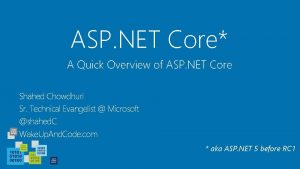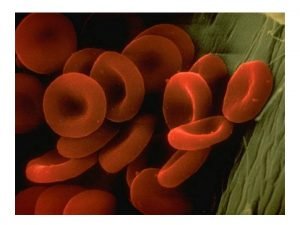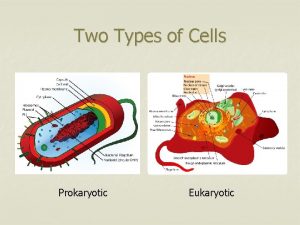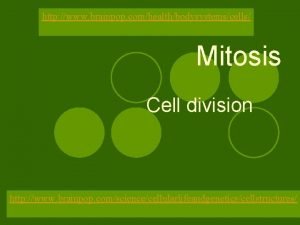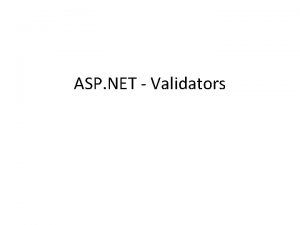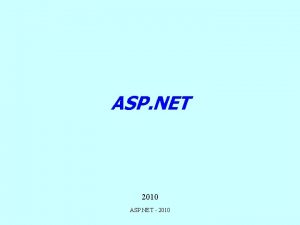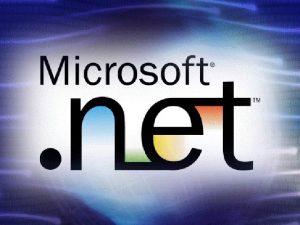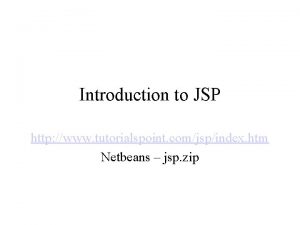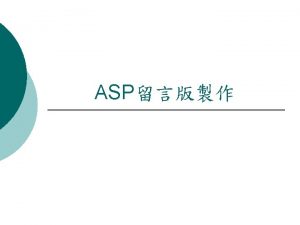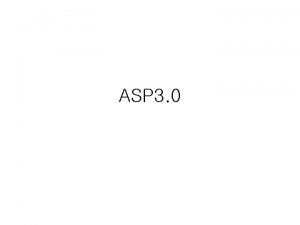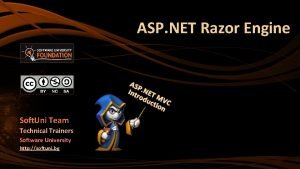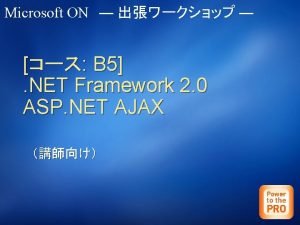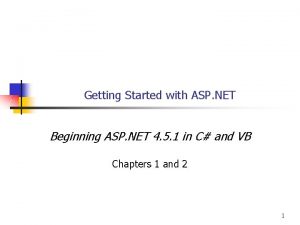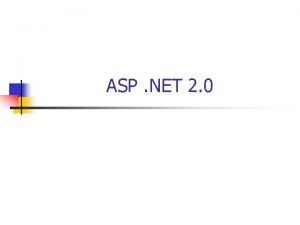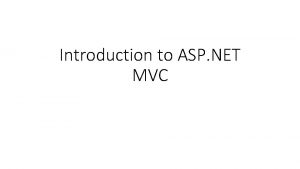ASP NET http www tutorialspoint comasp netfirstexample htm
















- Slides: 16

ASP. NET http: //www. tutorialspoint. com/asp. net_first_example. htm

What is ASP. Net? � ASP. Net is a web development platform, which provides a programming model, a comprehensive software infrastructure and various services required to build up robust web application for PC, as well as mobile devices. � ASP. Net works on top of the HTTP protocol and uses the HTTP commands and policies to set a browser-to-server two-way communication and cooperation. � ASP. Net is a part of Microsoft. Net platform. ASP. Net applications are complied codes, written using the extensible and reusable components or objects present in. Net framework. These codes can use the entire hierarchy of classes in. Net framework. � The ASP. Net application codes could be written in either of the following languages: �C# �Visual Basic. Net �Jscript �J# � ASP. Net is used to produce interactive, data-driven web applications over the internet. It consists of a large number of controls like text boxes, buttons and labels for assembling, configuring and manipulating code to create HTML pages.

ASP. Net Web Forms Model � ASP. Net web forms extend the event-driven model of interaction to the web applications. The browser submits a web form to the web server and the server returns a full markup page or HTML page in response. � All client side user activities are forwarded to the server for stateful processing. The server processes the output of the client actions and triggers the reactions. � Now, HTTP is a stateless protocol. ASP. Net framework helps in storing the information regarding the state of the application, which consists of: � Page state � Session state � The page state is the state of the client, i. e. , the content of various input fields in the web form. The session state is the collective obtained from various pages the user visited and worked with, i. e. , the overall session state. To clear the concept, let us take up an example of a shopping cart as follows. � User adds items to a shopping cart. Items are selected from a page, say the items page, and the total collected items and price are shown in a different page, say the cart page. Only HTTP cannot keep track of all the information coming from various pages. ASP. Net session state and server side infrastructure keeps track of the information collected globally over a session. � The ASP. Net runtime carries the page state to and from the server across page requests while generating the ASP. Net runtime codes and incorporates the state of the server side components in hidden fields. � This way the server becomes aware of the overall application state and operates in a two-tiered connected way.

ASP. Net Component Model: � The ASP. Net component model provides various building blocks of ASP. Net pages. Basically it is an object model, which describes: � Server side counterparts of almost all HTML elements or tags, like <form> and <input>. � Server controls, which help in developing complex user-interface for example the Calendar control or the Gridview control. � ASP. Net is a technology, which works on the. Net framework that contains all web-related functionalities. The. Net framework is made of an object-oriented hierarchy. An ASP. Net web application is made of pages. When a user requests an ASP. Net page, the IIS delegates the processing of the page to the ASP. Net runtime system. � The ASP. Net runtime transforms the. aspx page into an instance of a class, which inherits from the base class Page of the. Net framework. Therefore, each ASP. Net page is an object and all its components i. e. , the server-side controls are also objects.

Components of. Net Framework �Before going to the next session on Visual Studio. Net, let us look at the various components of the. Net framework 3. 5. The following table describes the components of the. Net framework 3. 5 and the job they perform:

Components and their Description (1) Common Language Runtime or CLR � It performs memory management, exception handling, debugging, security checking, thread execution, code safety, verification and compilation. Those codes which are directly managed by the CLR are called the managed code. When the managed code is compiled, the compiler converts the source code into a CPU independent intermediate language (IL) code. A Just in time compiler (JIT) compiles the IL code into native code, which is CPU specific. (2). Net Framework Class Library � It contains a huge library of reusable types. classes, interfaces, structures and enumerated values, which are collectively called types. (3) Common Language Specification � It contains the specifications for the. Net supported languages and implementation of language integration. (4) Common Type System � It provides guidelines for declaring, using and managing types at runtime, and cross- language communication. � Metadata and Assemblies � Metadata is the binary information describing the program, which is either stored in a portable executable file (PE) or in the memory. Assembly is a logical unit consisting of the assembly manifest, type metadata, IL code and set of resources like image files etc. (5) Windows Forms

Components and their Description (6) ASP. Net and ASP. Net AJAX � ASP. Net is the web development model and AJAX is an extension of ASP. Net for developing and implementing AJAX functionality. ASP. Net AJAX contains the components that allow the developer to update data on a website without a complete reload of the page. (7) ADO. Net � It is the technology used for working with data and databases. It provides accesses to data sources like SQL server, OLE DB, XML etc. The ADO. Net allows connection to data sources for retrieving, manipulating and updating data. (8) Windows Workflow Foundation (WF) � It helps in building workflow based applications in Windows. It contains activities, workflow runtime, workflow designer and a rules engine. (9)Windows Presentation Foundation � It provides a separation between the user interface and the business logic. It helps in developing visually stunning interfaces using documents, media, two and three dimensional graphics, animations and more. (10) Windows Communication Foundation (WCF) � It is the technology used for building and running connected systems.

Components and their Description (11) Windows Card. Space � It provides safety of accessing resources and sharing personal information on the internet. (12) LINQ � It imparts data querying capabilities to. Net languages using a syntax which is similar to the tradition query language SQL.

Visual Studio IDE �ASP. Net provides an abstraction layer on top of HTTP on which the web applications are built. It provides high-level entities like classes and components within an object-oriented paradigm. �The key development tool for building ASP. Net applications and front ends is Visual Studio. In these tutorials, we will work on Visual Studio 2008. �Visual Studio is an integrated development environment for writing, compiling and debugging the code. It provides a complete set of development tools for building ASP. Net web applications, web services, desktop applications and mobile applications.

The Visual Studio IDE: �The new project window allows choosing an application template from the available templates.


Visual Studio IDE � When you start a new web site, ASP. NET provides the starting folders and files for the site, including two files for the first web form of the site. � The file named Default. aspx contains the HTML and asp code that defines the form, and the file named Default. aspx. cs (for C# coding) or the file named Default. aspx. vb (for vb coding) contains the code in the language you have chosen and this code is responsible for the form's works. � The primary window in the Visual Studio IDE is the Web Forms Designer window. Other supporting windows are the Toolbox, the Solution Explorer, and the Properties window. You use the designer to design a web form, to add code to the control on the form so that the form works according to your need, you use the code editor.

Ways to work with views and windows The following are the ways to work with different windows: �To change the Web Forms Designer from one view to another, click on the Design or source button. �To close a window, click on the close button on the upper right corner and to redisplay, select it from the View menu. �To hide a window, click on its Auto Hide button; the window changes into a tab, to redisplay again click on the Auto Hide button again. �To size a wind just drag it.

Projects and Solutions � A typical ASP. Net application consists of many items: the web content files (. aspx), source files (e. g. , the. cs files), assemblies (e. g. , the. dll files and. exe files), data source files (e. g. , . mdb files), references, icons, user controls and miscellaneous other files and folders. All these files that make up the website are contained in a Solution. � When a new website is created VB 2008 automatically creates the solution and displays it in the solution explorer. � Solutions may contain one or more projects. A project contains content files, source files, and other files like data sources and image files. Generally the contents of a project are compiled into an assembly as an executable file (. exe) or a dynamic link library (. dll) file. � Typically a project contains the following content files: � Page file (. aspx) � User control (. ascx) � Web service (. asmx) � Master page (. master) � Site map (. sitemap) � Website configuration file (. config)

Building and Running a Project: �The application is run by selecting either Start or Start Without Debugging from the Debug menu, or by pressing F 5 or Ctrl-F 5. The program is built i. e. the. exe or the. dll files are generated by selecting a command from the Build menu.

ASP. Net Page Life Cycle Following are the different stages of an ASP. Net page: � Page request. when ASP. Net gets a page request, it decides whether to parse and compile the page or there would be a cached version of the page; accordingly the response is sent � Starting of page life cycle. at this stage, the Request and Response objects are set. If the request is an old request or post back, the Is. Post. Back property of the page is set to true. The UICulture property of the page is also set. � Page initialization. at this stage, the controls on the page are assigned unique ID by setting the Unique. ID property and themes are applied. For a new request postback data is loaded and the control properties are restored to the view-state values. � Page load. at this stage, control properties are set using the view state and control state values. � Validation. Validate method of the validation control is called and if it runs successfully, the Is. Valid property of the page is set to true. � Postback event handling. if the request is a postback (old request), the related event handler is called. � Page rendering. at this stage, view state for the page and all controls are saved. The page calls the Render method for each control and the output of rendering is written to the Output. Stream class of the Page's Response property. � Unload. the rendered page is sent to the client and page properties, such as Response and Request are unloaded and all cleanup done.
 Asp net tutorialspoint
Asp net tutorialspoint North south east west globe
North south east west globe Classic asp to asp.net migration
Classic asp to asp.net migration Http://www.blueplanetbiomes.org/world_biomes.htm
Http://www.blueplanetbiomes.org/world_biomes.htm Http://www.blueplanetbiomes.org/world_biomes.htm
Http://www.blueplanetbiomes.org/world_biomes.htm Www.youtu b
Www.youtu b Summary of meiosis
Summary of meiosis Plant cell
Plant cell Savanna animals adaptations
Savanna animals adaptations Http://www.cellsalive.com/howbig.htm
Http://www.cellsalive.com/howbig.htm Http://www.tvdsb.on.ca/westmin/science/snc2g1/frogresp.htm
Http://www.tvdsb.on.ca/westmin/science/snc2g1/frogresp.htm Cellsalive.com
Cellsalive.com Http://www.cellsalive.com/meiosis.htm
Http://www.cellsalive.com/meiosis.htm Buchinghamshire
Buchinghamshire Http //elements.wlonk.com/elements table.htm
Http //elements.wlonk.com/elements table.htm Http://www.cellsalive.com/
Http://www.cellsalive.com/ Prophase metaphase anaphase telophase
Prophase metaphase anaphase telophase


